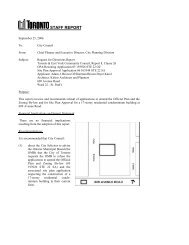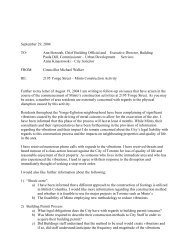Residential Tenancy Reform Consultation Paper
Residential Tenancy Reform Consultation Paper - Michael Walker
Residential Tenancy Reform Consultation Paper - Michael Walker
You also want an ePaper? Increase the reach of your titles
YUMPU automatically turns print PDFs into web optimized ePapers that Google loves.
RESIDENTIAL TENANCY REFORM CONSULTATION PAPER<br />
Table 1: Vacancy Rates in Ontario’s CMAs (All bedroom types)<br />
Private Rental Apartment Buildings of Three Units & Over<br />
Ontario CMAs 1991 1992 1993 1994 1995 1996 1997 1998 1999 2000 2001 2002 2003<br />
(In per cent)<br />
Greater Sudbury 0.7 2.5 3.8 4.3 6.0 6.8 7.2 9.4 11.1 7.7 5.7 5.1 3.6<br />
Hamilton 1.6 2.3 2.7 2.7 2.0 2.2 3.1 3.2 1.9 1.7 1.3 1.6 3.0<br />
Kingston 1.5 1.9 2.5 2.9 3.2 4.2 5.3 5.4 3.4 1.8 1.5 0.9 1.9<br />
Kitchener 4.3 4.4 4.3 2.8 2.2 1.8 1.9 1.5 1.0 0.7 0.9 2.3 3.2<br />
London 3.9 3.4 3.8 4.1 4.3 6.0 5.1 4.5 3.5 2.2 1.6 2.0 2.1<br />
Oshawa 3.4 6.1 4.6 3.4 2.7 3.7 2.4 2.0 1.7 1.7 1.3 2.3 2.9<br />
Ottawa 0.8 1.3 1.8 2.6 3.8 4.9 4.2 2.1 0.7 0.2 0.8 1.9 2.9<br />
St. Catharines – Niagara 2.9 3.4 4.9 5.8 5.2 5.6 5.4 4.6 3.2 2.6 1.9 2.4 2.7<br />
Thunder Bay 1.0 2.5 2.7 4.1 6.2 5.6 7.7 9.3 7.5 5.8 5.8 4.7 3.3<br />
Toronto 1.8 2.2 2.0 1.2 0.8 1.2 0.8 0.8 0.9 0.6 0.9 2.5 3.8<br />
Windsor 3.3 3.3 2.7 1.6 1.8 2.8 4.5 4.3 2.7 1.9 2.9 3.9 4.3<br />
Ontario 2.2 2.6 2.7 2.4 3.0 3.0 2.8 2.6 2.1 1.6 1.7 2.7 3.5<br />
Source: CMHC Rental Market Survey conducted every year in October<br />
The primary reason for the increases in vacancy rates has<br />
been a decline in rental demand, not a high increase in new<br />
supply. A number of renter households have taken advantage<br />
of the historically low mortgage rates and have made<br />
the transition into homeownership. There has also been a<br />
dip in net migration in 2003 and in youth employment<br />
(age cohort of 15-24), discouraging the formation of new<br />
renter households (both these groups are dominant renter<br />
categories).<br />
However, the trend of rising vacancy rates over the past<br />
two years may be temporary. Vacancy rates tend to be<br />
cyclical. The early and mid-1990s witnessed the same<br />
trend, when vacancy rates rose above 3 per cent in many<br />
urban areas. This was followed by a period of record low<br />
vacancies until the end of the decade, before the current<br />
easing — which is expected to continue for a few more<br />
years.<br />
Demand for rental units is likely to rise after a few years.<br />
The formation of new renter households will increase with<br />
growth in youth employment as the economy improves<br />
(many persons in the age group of 15-24 will probably<br />
move out of their parents’ home and into separate residences).<br />
Also, as mortgage rates start to rise after some<br />
time, the number of renters moving into homeownership<br />
will decline. Immigration levels in Ontario are not projected<br />
to rise in the next two years; however, if there is an increase,<br />
this could result in higher demand for rental units.<br />
Vacancy rates in low rent units<br />
In the past several years, any easing in the rental market<br />
conditions in the larger centres generally occurred at the<br />
higher rent levels. Here, the increases in income and lower<br />
interest rates (compared to early 1990s) made home ownership<br />
attainable and preferable for many renter households,<br />
especially those paying high rents. The more affordable<br />
and low rent units remained in tight supply, with the<br />
vacancy rates for these units generally remaining low.<br />
However, in the 2003 survey, while vacancy rates rose<br />
across the rent spectrum in several larger urban centres,<br />
the vacancy rates in units with lower rents (across all bedroom<br />
types) had higher increases than the higher rent units.<br />
In Toronto, in the two-bedroom category, the vacancy rate<br />
in 2003 for units renting for less than $700 increased to<br />
3.3 per cent, and for units between $701-$800 increased<br />
to 5.6 per cent. (The increases were 1.3 per cent and 1.7<br />
33






